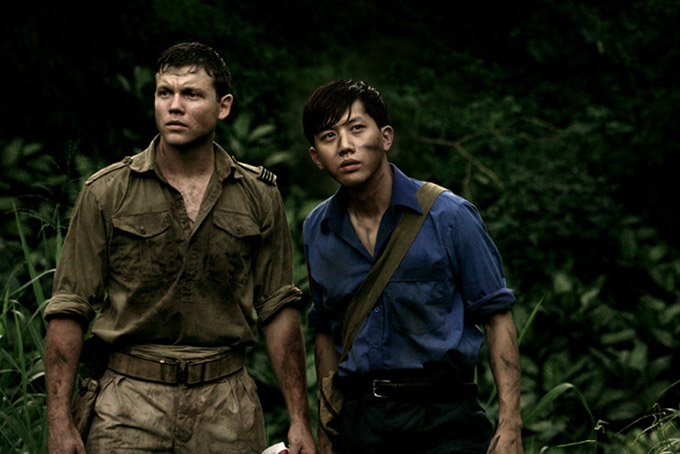Canopy
by George Sax

Australian writer-director Aaron Wilson’s vividly riveting Canopy exemplifies the powerful visceral resources motion pictures can deploy. Canopy unfolds like a dream experience, and if for much of its short length (84 minutes) this can seem a nightmarish one, the movie is also almost mesmerizingly beautiful.
It’s a war movie, but don’t expect the conventions of that genre. Wilson hasn’t so much defied as ignored them as he goes after effects that don’t rely on the usual concerns and devices of movie war stories. Wilson has sought to create the kind of film experience that quickly and sharply reduces an audience’s separation from what’s on the screen. And he does that in Canopy’s opening minutes. After broad, compelling visual compositions of dense jungle, and, per the title, a high overspreading of foliage, there are brief shots of fighter planes above. Then we’re confronted with an apparently stunned airman hanging by his parachute lines from a tree. After he disengages himself and drops to earth, he enters into a severe ordeal as he tries to evade Japanese soldiers and make his way to some unidentified place of safety. It is, of course, the Second World War and the very young Australian flier, Jim (Khan Chittenden), is in Singapore.
We can’t really know all this, and can only guess at some of it, because the movie’s first ten or so minutes have no dialogue or onscreen texts. In fact, Canopy is largely devoid of speech and specific information for most of its length.
After a spell of walking, staggering and groping through the tropical forest, Jim (literally) runs into another young man, an Asian (Tzu-yi Mo). He’s a survivor of a Singapore army unit who’s fleeing the Japanese too. A viewer can’t know this for sure, and with no more than a very few exchanged hand gestures, these two set off together on what becomes a joint escape trial.
There is, of course, narrative structure in Canopy, but there are significant stretches when it is either inflected or overshadowed by the movie’s heightened formal techniques and its sensual elements. Sometimes these generate emotional involvement, but elsewhere they’re distancing, however impressively wrought they are.
Wilson and cinematographer Stefan Duscio photograph the two actors in sharp light and dark relief, or in the middle of wide landscape shots. They also close in on their faces to capture the characters’ thinking and reactions, and it’s effective. But it’s also part of Canopy’s heavily aesthetic approach to its material. Despite the dramatic tension, there’s a strong countervailing formality. (Think Terrence Malick and his Tree of Life for a partial reference point.)
In public statements Wilson has expressed interest in the humane historical and psychological ideas he says are behind the movie, but Canopy serves them only in an attenuated way. It’s a very accomplished work, but its aestheticized obscurity can be as frustrating as it is involving.
Watch the trailer for Canopy
|
Issue Navigation> Issue Index > v13n37 (Week of Thursday, September 11) > Film Reviews > Canopy This Week's Issue • Artvoice Daily • Artvoice TV • Events Calendar • Classifieds |









 Current Issue
Current Issue